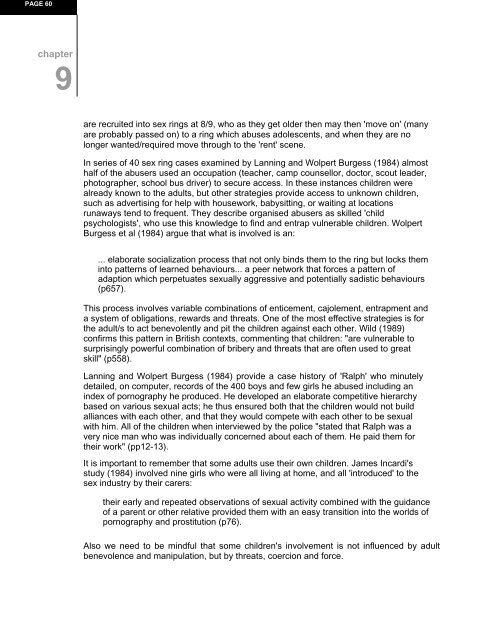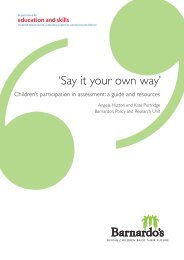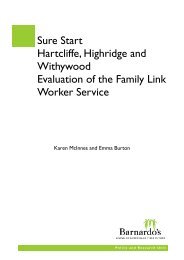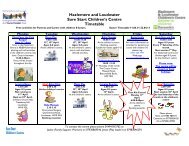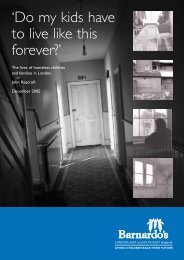Splintered Lives - Barnardo's
Splintered Lives - Barnardo's
Splintered Lives - Barnardo's
You also want an ePaper? Increase the reach of your titles
YUMPU automatically turns print PDFs into web optimized ePapers that Google loves.
PAGE 60<br />
chapter<br />
9<br />
are recruited into sex rings at 8/9, who as they get older then may then 'move on' (many<br />
are probably passed on) to a ring which abuses adolescents, and when they are no<br />
longer wanted/required move through to the 'rent' scene.<br />
In series of 40 sex ring cases examined by Lanning and Wolpert Burgess (1984) almost<br />
half of the abusers used an occupation (teacher, camp counsellor, doctor, scout leader,<br />
photographer, school bus driver) to secure access. In these instances children were<br />
already known to the adults, but other strategies provide access to unknown children,<br />
such as advertising for help with housework, babysitting, or waiting at locations<br />
runaways tend to frequent. They describe organised abusers as skilled 'child<br />
psychologists', who use this knowledge to find and entrap vulnerable children. Wolpert<br />
Burgess et al (1984) argue that what is involved is an:<br />
... elaborate socialization process that not only binds them to the ring but locks them<br />
into patterns of learned behaviours... a peer network that forces a pattern of<br />
adaption which perpetuates sexually aggressive and potentially sadistic behaviours<br />
(p657).<br />
This process involves variable combinations of enticement, cajolement, entrapment and<br />
a system of obligations, rewards and threats. One of the most effective strategies is for<br />
the adult/s to act benevolently and pit the children against each other. Wild (1989)<br />
confirms this pattern in British contexts, commenting that children: "are vulnerable to<br />
surprisingly powerful combination of bribery and threats that are often used to great<br />
skill" (p558).<br />
Lanning and Wolpert Burgess (1984) provide a case history of 'Ralph' who minutely<br />
detailed, on computer, records of the 400 boys and few girls he abused including an<br />
index of pornography he produced. He developed an elaborate competitive hierarchy<br />
based on various sexual acts; he thus ensured both that the children would not build<br />
alliances with each other, and that they would compete with each other to be sexual<br />
with him. All of the children when interviewed by the police "stated that Ralph was a<br />
very nice man who was individually concerned about each of them. He paid them for<br />
their work" (pp12-13).<br />
It is important to remember that some adults use their own children. James Incardi's<br />
study (1984) involved nine girls who were all living at home, and all 'introduced' to the<br />
sex industry by their carers:<br />
their early and repeated observations of sexual activity combined with the guidance<br />
of a parent or other relative provided them with an easy transition into the worlds of<br />
pornography and prostitution (p76).<br />
Also we need to be mindful that some children's involvement is not influenced by adult<br />
benevolence and manipulation, but by threats, coercion and force.


